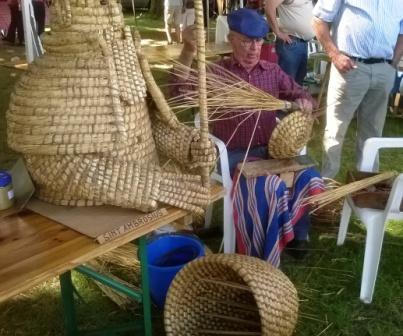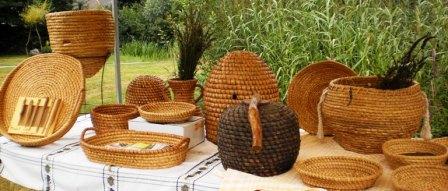 A box is much more handsome. But a basket already is much easier to handle than a hollow tree. Previously, nearly every farmer had his own hives. After the bees in hollow tree trunks came the first baskets 'bishop hats' braided willow twigs with on the top of the point, a kind of handle. The whole was smeared with cow dung and dried.
A box is much more handsome. But a basket already is much easier to handle than a hollow tree. Previously, nearly every farmer had his own hives. After the bees in hollow tree trunks came the first baskets 'bishop hats' braided willow twigs with on the top of the point, a kind of handle. The whole was smeared with cow dung and dried.
Later they were made of sturdy rye straw (or even of purple moor grass or hair grass) and split –one year old not-branched foothills of the common blackberry (Rubus fruticosus.) That was cut in the autumn, flattened trough a buffed cow horn to zip off the thorns, split in three or four, and the (inner) pit was scraped off. The straw was passed through a short tube (horn) or ring to get strict equal thickness for a realskep wicker hive (straw hive).
An oak needle is used to puncture the previous straw band, to sew them firmly together.
You take a bundle of straw, squeeze it together until the thickness of a hefty men thumb, turn there at the end a burr tape a few times around and in between, bend the starting point at an angle of ninety degrees and then start the strap winding around it. Note that the straw band remains of equal thickness. He becomes thinner because the blades are not equally long, then you need to stab a new wrapped bundle in the previous.
(You can as well make baskets this way.)
The bars were made of buckthorn (Rhamnus Buckthorn).
Possibly pieces of comb were fused as starter. These were then mounted in the head of the basket so that the honeycomb pieces were perpendicular to the entrance.
Instead of comb some use triangular cut bars that are inserted, with the sharp edge downwards at distances of 3.5 cm. On this tighten side the bees start then with working (making honeycomb).
To harvest a colony was chased to continue palpitation on 2 baskets inverted to each other. The lower basket contains the people to hunt out, the upper basket is empty. They began to knock down, to gradually, as the bees go up, beat higher. "This beating must be done with both hands simultaneously in front and behind at the basket to prevent to break the honeycomb. When after about fifteen minutes the bees run well, what one can hear on rustling, then the side facing the beater the above basket can me mounted, by replacing the staples on this side a little. Through this opening can then be observed the run and can occasionally be brought a little movement in the bee mass by means of smoke or some stick."

